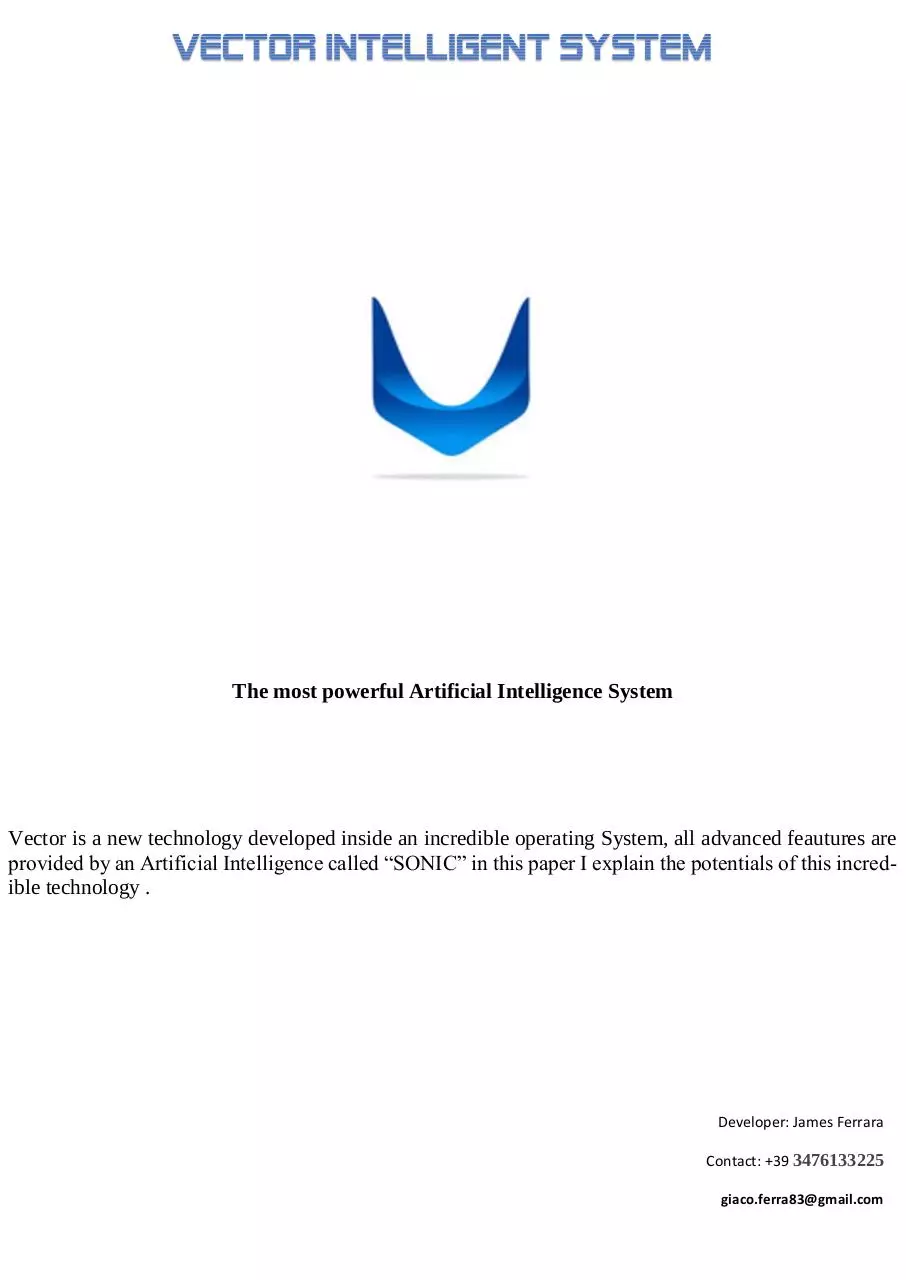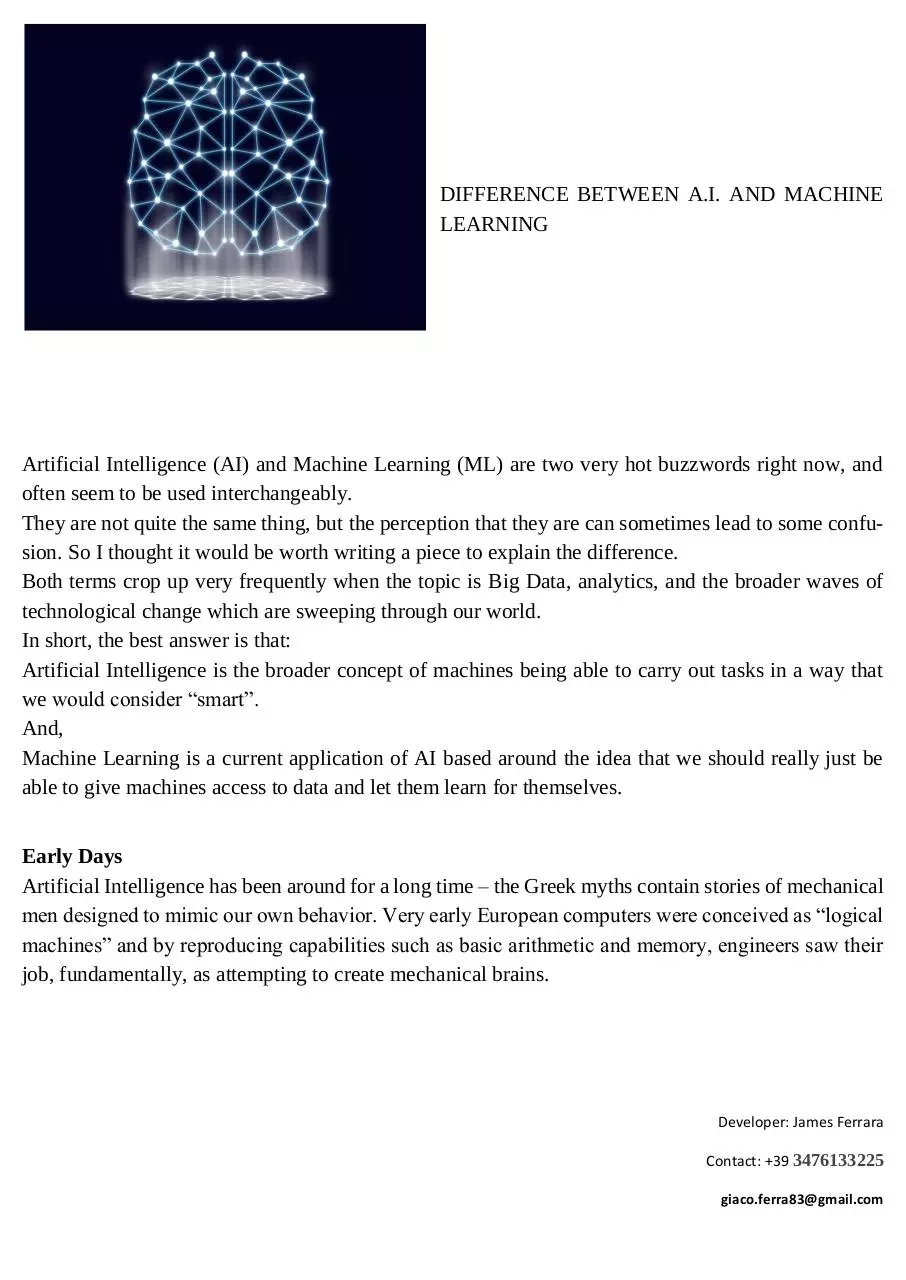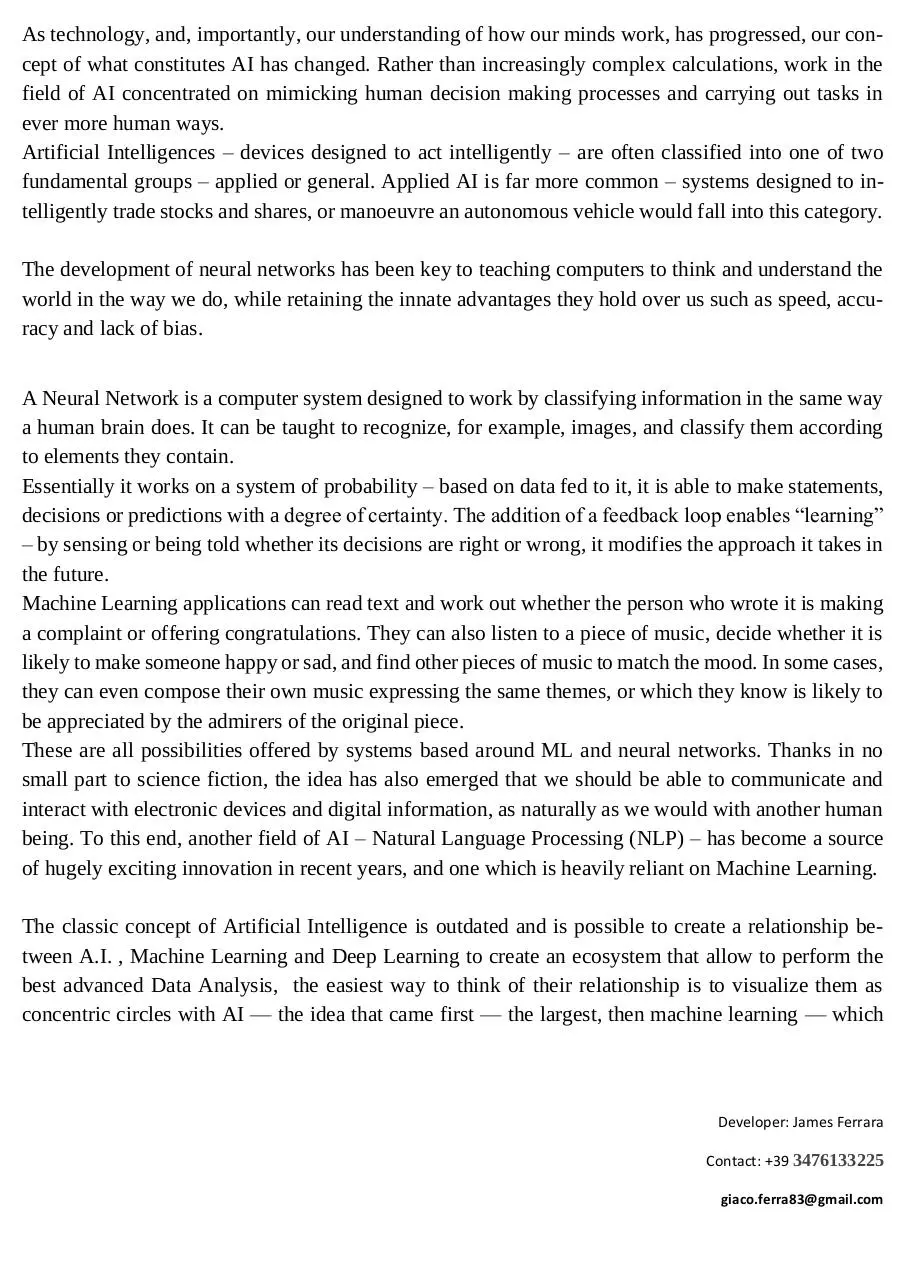brochure (PDF)
File information
Title: RealEstate-Brochure
This PDF 1.7 document has been generated by Microsoft® Word 2016, and has been sent on pdf-archive.com on 23/03/2018 at 22:38, from IP address 93.146.x.x.
The current document download page has been viewed 394 times.
File size: 1.51 MB (67 pages).
Privacy: public file





File preview
The most powerful Artificial Intelligence System
Vector is a new technology developed inside an incredible operating System, all advanced feautures are
provided by an Artificial Intelligence called “SONIC” in this paper I explain the potentials of this incredible technology .
Developer: James Ferrara
Contact: +39 3476133225
giaco.ferra83@gmail.com
This page was intentionally empty…..
Developer: James Ferrara
Contact: +39 3476133225
giaco.ferra83@gmail.com
DIFFERENCE BETWEEN A.I. AND MACHINE
LEARNING
Artificial Intelligence (AI) and Machine Learning (ML) are two very hot buzzwords right now, and
often seem to be used interchangeably.
They are not quite the same thing, but the perception that they are can sometimes lead to some confusion. So I thought it would be worth writing a piece to explain the difference.
Both terms crop up very frequently when the topic is Big Data, analytics, and the broader waves of
technological change which are sweeping through our world.
In short, the best answer is that:
Artificial Intelligence is the broader concept of machines being able to carry out tasks in a way that
we would consider “smart”.
And,
Machine Learning is a current application of AI based around the idea that we should really just be
able to give machines access to data and let them learn for themselves.
Early Days
Artificial Intelligence has been around for a long time – the Greek myths contain stories of mechanical
men designed to mimic our own behavior. Very early European computers were conceived as “logical
machines” and by reproducing capabilities such as basic arithmetic and memory, engineers saw their
job, fundamentally, as attempting to create mechanical brains.
Developer: James Ferrara
Contact: +39 3476133225
giaco.ferra83@gmail.com
As technology, and, importantly, our understanding of how our minds work, has progressed, our concept of what constitutes AI has changed. Rather than increasingly complex calculations, work in the
field of AI concentrated on mimicking human decision making processes and carrying out tasks in
ever more human ways.
Artificial Intelligences – devices designed to act intelligently – are often classified into one of two
fundamental groups – applied or general. Applied AI is far more common – systems designed to intelligently trade stocks and shares, or manoeuvre an autonomous vehicle would fall into this category.
The development of neural networks has been key to teaching computers to think and understand the
world in the way we do, while retaining the innate advantages they hold over us such as speed, accuracy and lack of bias.
A Neural Network is a computer system designed to work by classifying information in the same way
a human brain does. It can be taught to recognize, for example, images, and classify them according
to elements they contain.
Essentially it works on a system of probability – based on data fed to it, it is able to make statements,
decisions or predictions with a degree of certainty. The addition of a feedback loop enables “learning”
– by sensing or being told whether its decisions are right or wrong, it modifies the approach it takes in
the future.
Machine Learning applications can read text and work out whether the person who wrote it is making
a complaint or offering congratulations. They can also listen to a piece of music, decide whether it is
likely to make someone happy or sad, and find other pieces of music to match the mood. In some cases,
they can even compose their own music expressing the same themes, or which they know is likely to
be appreciated by the admirers of the original piece.
These are all possibilities offered by systems based around ML and neural networks. Thanks in no
small part to science fiction, the idea has also emerged that we should be able to communicate and
interact with electronic devices and digital information, as naturally as we would with another human
being. To this end, another field of AI – Natural Language Processing (NLP) – has become a source
of hugely exciting innovation in recent years, and one which is heavily reliant on Machine Learning.
The classic concept of Artificial Intelligence is outdated and is possible to create a relationship between A.I. , Machine Learning and Deep Learning to create an ecosystem that allow to perform the
best advanced Data Analysis, the easiest way to think of their relationship is to visualize them as
concentric circles with AI — the idea that came first — the largest, then machine learning — which
Developer: James Ferrara
Contact: +39 3476133225
giaco.ferra83@gmail.com
blossomed later, and finally deep learning — which is driving today’s AI explosion — fitting inside
both.
Developer: James Ferrara
Contact: +39 3476133225
giaco.ferra83@gmail.com
But if more people try to combine these feautures for scientifics approaches, for Computer Science or
mathematical purpouse etc nobody thinks that 3 law of asimov rules says that “A robot must protect
its own existence as long as such protection does not conflict with the First or Second Laws” , so we
can use this law to create an advanced deep security systems that combine Active Defence solutions ,
Endpoint Protection and all feautures about Artificial Intelligence studies together on the same enviroment . But how is possible ? The answer is only one….
Vector
Vector is the ultimate security system, all you want inside a unique powerfull Operating System, it
focuses its power on an incredible set of components called “OLYMPUS” that grants for single users,
companies (smalls, middles and larges), banks, crytical infrastructures and defense systems a 360°
solution that evolves in real time and without any human interaction.Vector is the result of years of
study and technical analysis to evaluate the real cyber threats by querying all archives (cve , cvs ,
0day , Microsft bullettins etc) that newtork administrators use against cyber criminal , but is only one
in thousands of options for Vector and I a begin of a new world A REAL SAFE WORLD.
Developer: James Ferrara
Contact: +39 3476133225
giaco.ferra83@gmail.com
Olympus is the centre of all feautures inside Vector but effectively to make the magic of totally and
always evolved impenetrability the core of system is the Deep Learning Artificial Subroutine that
transforms all informations in a operative strategy, I named this SONIC.
SONIC
SONIC is not a simple defense mechanism, IS ALL YOU WANT AND MORE because the entire
Vector infrastrucrure is created to continuously evolve in the time without voluntarily commands by
administrator.
Why this ? To show the purpouse of this strategy I need to explain the methodology used to create
the platform , all based on my personal experiences obtained during my long career of penetration
tester , white hat and cyber security experts for all kind of infrastructures . I have to thank my experiences in the field of military cyber security that open my mind to understand that the cyber world is
on the threshold of the abyss of the totally computer anarchy and we need a help , a partner that grants
Developer: James Ferrara
Contact: +39 3476133225
giaco.ferra83@gmail.com
a full power control over the network against the people that thinks the net like a world without rules ,
where you can violate not only systems but human actors , where a bad person can destroy your life
and remain umpunished, but this time may finish and the key of this change is Vector .
Sonic become works on dynamic threats and is able to adapt to the security measures deployed by
users and organizations to combat cybercrime.
In this context, one major challenge is unquestionably the classification of malware. The malware that
seems to be “fashionable” today is already obsolete tomorrow and is replaced by another one with
completely different or improved features.
At the same time, the newest varieties of malware continue to coexist with older forms, which are still
used by cyber criminals without the means to innovate. Therefore, classification in the cybercriminal
ecosystem is very complex.
One of the best feauture is that it makes it possible to learn from this dynamism in real time and
develop new classification criteria without human intervention. Thanks to this, detection and classification become much more efficient and proactive.
At the same time, its applications are infinite, for example, we also use SONIC together with our
development of identification based on biometric behavior. This allows us to rapidly recognize
whether a person is interacting with their computer or it is a bot, or if there is a cybercriminal attempting a user or interacting with a user’s account from anywhere in the world.
Machine learning is a key technology in the Sonic System security with a multi-layered approach to
protecting endpoints and systems against different threats, blending traditional security technologies
with newer ones and using the right technique at the right time.
For over 5 years I’ve increased the power of machine learning to eliminate spam emails, calculate
web reputation, and chase down malicious social media activity and Sonic is the best product because
has the ability to auto-develope the latest machine learning algorithms to analyze large volumes of
data and predict the maliciousness of previously unknown file types.
Developer: James Ferrara
Contact: +39 3476133225
giaco.ferra83@gmail.com
THE HUMAN VULNERABILITY
The worst vulnerability that affects all systems is always the human factor , the weak that all attackers
plan to create all malicious campaigns.
Most Operating Systems try to abstract human factor from main systems operations for example an
abstraction for protection is the execution of an application program with restricted rights allowing a
safe communication between hardware and critical systems components. OS tracks program counter
and process has a stack that forces OS to track stack pointer and Process Control Block (PCB) Data
(program instructions, stack & heap) inspects memory metadata is in PCB etc, but this doesn’t resolve
the problem.
Developer: James Ferrara
Contact: +39 3476133225
giaco.ferra83@gmail.com
Download brochure
brochure.pdf (PDF, 1.51 MB)
Download PDF
Share this file on social networks
Link to this page
Permanent link
Use the permanent link to the download page to share your document on Facebook, Twitter, LinkedIn, or directly with a contact by e-Mail, Messenger, Whatsapp, Line..
Short link
Use the short link to share your document on Twitter or by text message (SMS)
HTML Code
Copy the following HTML code to share your document on a Website or Blog
QR Code to this page

This file has been shared publicly by a user of PDF Archive.
Document ID: 0000748756.